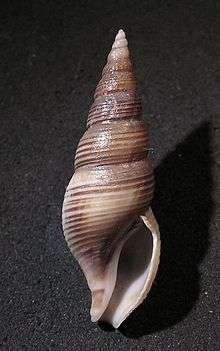Ophiodermella inermis
| Ophiodermella inermis | |
|---|---|
 | |
| Apertural view of a shell of Ophiodermella inermis | |
| Scientific classification | |
| Kingdom: | Animalia |
| Phylum: | Mollusca |
| Class: | Gastropoda |
| Clade: | Caenogastropoda |
| Clade: | Hypsogastropoda |
| Clade: | Neogastropoda |
| Superfamily: | Conoidea |
| Family: | Borsoniidae |
| Genus: | Ophiodermella |
| Species: | O. inermis |
| Binomial name | |
| Ophiodermella inermis (Reeve, 1843) | |
| Synonyms[1] | |
| |
Ophiodermella inermis is a species of sea snail, a marine gastropod mollusk in the family Borsoniidae.[1]
Description
The shell grows to a length of 40 mm, its width 7 mm.
The shell is pinkish ash-colored under a light olivaceous epidermis. The lines of growth are sometimes rib-like, oblique and angulated at the periphery and lighter-colored, so that the interspaces appear like angulated lines of chestnut or reddish narrow stripes. The whole surface is covered by close revolving incised lines.[2]
The small shell is slender and very acute. Its color is of a livid purple. The shell is covered with an olivaceous periostracum, with about eleven whorls. The protoconch is more or less eroded, but apparently smooth, acute, and including about two and a half whorls. The subsequent whorls are rather flat, compressed and appressed at and in front of the suture, with a rounded base and inconspicuous anal fasciole. The sculpture consists chiefly of flattish spiral threads, one at the suture, three smaller ones in front of it, followed by a flat broader one representing the fasciole, then (on the body whorl eight) more prominent threads, undulate or segmented by incremental lines and with wider interspaces (sometimes containing an intercalary smaller thread) to the base, followed by six or seven unsegmented threads to the siphonal fasciole, which bears six or seven smaller threads. The succession of undulations or slightly swollen segments gives a slightly cancellate ellect to the part of the whorl which bears them, but there are no axial ribs, the etfect being produced rather by depressions between the rather coarse incremental lines. The aperture is narrow and acute behind. The anal sulcus is narrow and distinct but not very deep. The outer lip in front of it is arcuately produced. The siphonal canal is contracted, short, and recurved. Theis inner lip polished and superficially erased. The columellla is twisted, with a thin layer of callus. An operculum is present.[3]
Distribution
This species occurs in the Pacific Ocean from Alaska to California.
References
- 1 2 Ophiodermella inermis (Reeve, 1843). Retrieved through: World Register of Marine Species on 14 August 2011.
- ↑ George Washington Tryon, Manual of Conchology vol. VI, p. 182; 1884 (described as Drillia incisa)
- ↑ W.H. Dall, .Descriptions of new species of mollusks from the Pacific coast of the United States; Proceedings of the United States National Museum v.34 1908 (described as Turris (Surcula) halcyonis)
- Carpenter, Proc. Acad. Nat. Sci. Phila. for 1865, p. 63, 1865
- Dall, Proc. U. S. Nat. Mus., vol. 34, No. 1610, p. 248, June 16, 1908.
- McLean J.H. (1996). The Prosobranchia. In: Taxonomic Atlas of the Benthic Fauna of the Santa Maria Basin and Western Santa Barbara Channel. The Mollusca Part 2 – The Gastropoda. Santa Barbara Museum of Natural History. volume 9: 1-160
External links
- Gastropods.com: Ophiodermella inermis
- Bartsch, P, Some turrid mollusks of Monterey Bay and vinicity; Proceedings of the Biological Society of Washington, v. 57 p. 57-68
| Wikimedia Commons has media related to Ophiodermella inermis. |